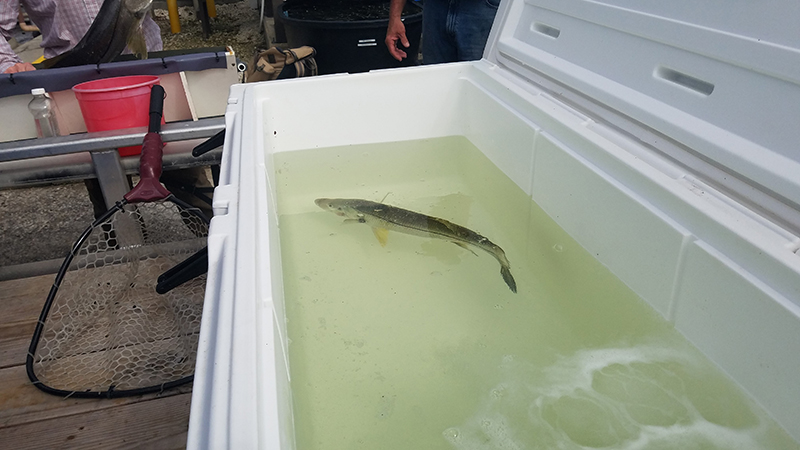- Snook, a prized game fish, have been moving farther north in the Gulf of Mexico during the last few decades as hard freezes become less frequent
- Researchers have tagged 20 snook to track their movements during the winter when the fish retreat to warmer inland waters
- Tracking data will help inform conservation efforts and future recreational snook fishing
University of Florida researchers have teamed up with the Florida Fish and Wildlife Conservation Commission and Duke Energy’s Crystal River Mariculture Center to tag and track snook, a tropical game fish prized by anglers.
The research is funded with a $25,800 Duke Energy Foundation grant awarded in 2020. The grant came after Duke Energy workers at the Crystal River Energy complex noticed snook congregating in the canal each winter for several years and reached out to the onsite Mariculture Center’s supervisor, who then contacted researchers at the University of Florida.

“This grant helps scientists gather valuable data and continue the good work they do every day to protect, restore and rehabilitate our state’s environmental treasures,” said Catherine Stempien, state president of Duke Energy Florida. “Such collaboration with our Mariculture Center is a good example of how at Duke Energy is committed to being both a good steward of the environment and a good community partner.”
During winter months, snook never used to be found in Florida north of Tarpon Springs because of sensitivity to colder water temperatures in northern areas of the Gulf of Mexico. But during the last two decades, snook have been appearing north of their historic range, including near Duke Energy’s Crystal River Energy Complex in Citrus County, about 85 miles north of Tampa. Today, anglers catch the sought-after fish in the Crystal River and Cedar Key areas – and sometimes farther north.
Recent University of Florida research has shown that fewer hard freezes in the region have allowed snook to establish a growing population in these northern waters. However, how snook have expanded their range remains a mystery. While freezes may be less frequent, the northern Gulf still experiences periodic cold snaps that would lead to most snook’s demise.
Now scientists are asking: How do snook manage to survive?
This winter, a research team led by Charles Martin, research assistant professor at the University of Florida Institute of Food and Agricultural Sciences Nature Coast Biological Station in Cedar Key, will work to find out.
“When ocean temperatures drop, snook have been found in rivers, streams and natural springs, which are warmer than the ocean,” Martin said. “This suggests that snook are moving to these areas to escape colder water. To confirm this, we need to track them and understand their migration patterns.”
As of Feb. 10, the [inlinetweet prefix=”” tweeter=”” suffix=””]UF, Florida Fish and Wildlife Conservation Commission and Duke Energy team have tagged a total of 20 snook, which will allow the team to track the fish’s migration patterns during the next several years.[/inlinetweet]

Tags attached to the fish will ping acoustic receivers installed at different points in Duke Energy’s Crystal River Energy Complex discharge canal, Cedar Key and the Suwannee and Waccasassa rivers, recording each snook as it moves between the ocean and inland waters. This data will also provide information about the snook’s life cycle, offering valuable insights about how the snook fishery is managed and the future of recreational snook fishing in the Gulf of Mexico.
Duke Energy’s Mariculture Center at the Crystal River Energy Complex supports recreational fishing and the environmental health of the Gulf of Mexico by cultivating and releasing more than 4 million fish and crustaceans into the Gulf. Since opening in 1991, the center has become one of the most successful marine-stocking programs in Florida. The center also grows submerged aquatic vegetation, such as freshwater eelgrass and saltwater marsh species like mangroves and cordgrass. Since 2014, the center has provided more than 8 million individual plants for springs and lake restoration projects as well as living shoreline projects along the Florida Panhandle and Nature Coast.
 0
0
